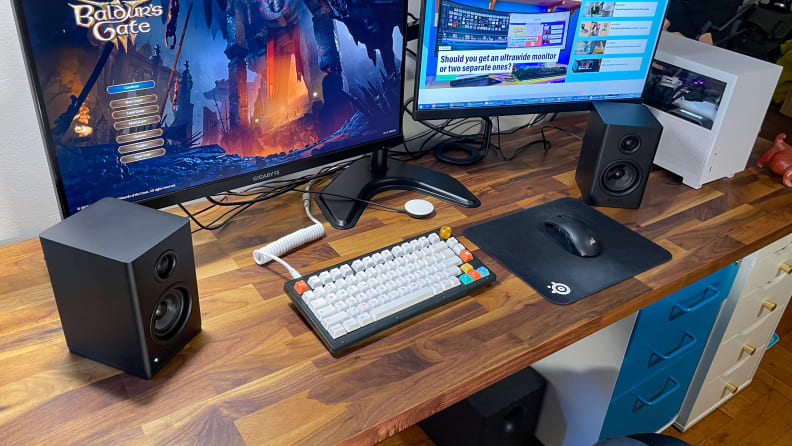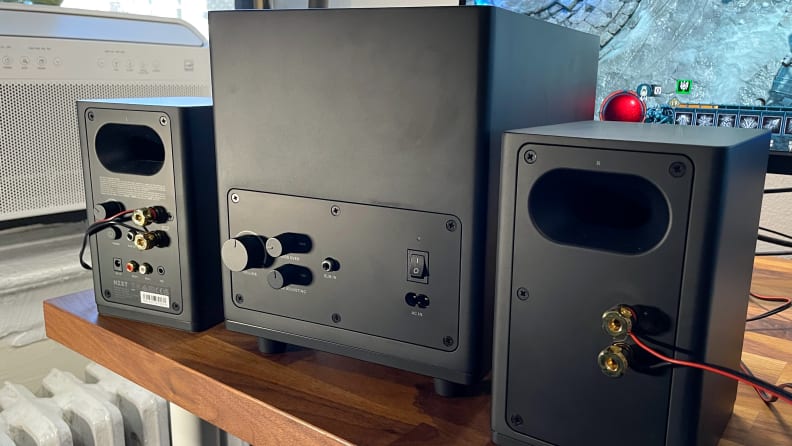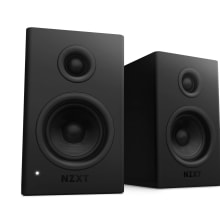Pros
-
Surprisingly well-balanced sound
-
Speakers have a lot of output for their size
-
Industrial design, fit-and-finish are quite nice
Cons
-
The subwoofer is not optional
-
Sub isn’t as loud as the speakers
-
Controls and connectivity are limited
About the NZXT Relay Speakers and Relay Subwoofer

With their matte finish, rounded corners, exposed drivers, and lack of visible controls, the little Relay Speakers are delightfully minimalist and easy on the eyes, and doubly so in white.
- Price: Relay Speakers: $250; Relay Subwoofer: $150
- Size: Relay Speakers: 7.32" (186 mm) x 4.53" (115 mm) x 6.26" (159 mm); Relay Subwoofer: 10" (254 mm) x 8.31" (211 mm) x 12.3" (312.5 mm)
- Weight: Relay Speakers: 3.5 lb (1.6 kg); Relay Subwoofer: 10.8 lb (4.9 kg)
- Amplification: Relay Speakers: 40 watts per channel peak (80 watts total); Relay Subwoofer: 140 watts peak
- Wireless connection: None
- Wired connection: Inputs: RCA, TRS; Outputs: subwoofer, speaker terminals
- Warranty: Two years
Each Relay Speaker is just 7.32 inches (186 mm) tall and 4.53 inches (115 mm) wide, with a 20mm soft-dome tweeter for high frequencies and a 3-inch (76.2 mm) glass fiber woofer for midrange and bass frequencies.
The subwoofer features a 6.5-inch down-firing paper cone in a bass-reflex enclosure measuring just 10 inches tall and a little over 8 inches wide. In other words, unless you live under a staircase, this isn’t a speaker system you could or should really use with your TV. Even by desktop standards, it’s quite compact.
That said, in a nearfield setup, the speakers and subwoofer deliver a rich, surprisingly well-balanced, and dynamic sound that’s a pleasant surprise. The frequency response isn’t ruler flat, but neither has it been tuned or tweaked with any particular genre in mind, so the system is a good fit for any type of desktop audio. The little bookshelf speakers in particular are also beautifully designed, with an elegant finish, nicely rounded corners, and a rubber bass that not only adds some no-slip functionality but also mechanically isolates the speakers, so they won’t rattle your desk. The lack of front-facing controls is a little irksome, as is the output mismatch between the speakers and sub.
What we like
Nicely balanced sound and good imaging

The NZXT Relay Speakers and Subwoofer make for a nicely engineered and beautifully built sound system that sounds far better than you’d expect at first glance.
Right out of the box, and without the benefit of the subwoofer, the NZXT Relay Speakers sound a bit bright, but only due to their lack of bass. From 80Hz or so (pretty close to the lowest note a cello can play) up to the highest frequencies, the tonal balance is reasonably neutral, except for a bit of a recess in the midrange and another dip pretty close to where the tweeter and woofer crossover at 1,600Hz.
As a result, if you play a song without much bass at all, such as “Fearless” from Pink Floyd’s pre- Dark Side masterpiece Meddle, you probably won’t feel like you’re missing much if anything.
The soundstage is shockingly wide, imaging is really good for speakers in this price range, and the sound has nice depth and dynamics. Load up something with a bit more bass, though—like the perennial audiophile test track, Tracy Chapman’s “Fast Car”—and the bass starts to sound congested and compressed, not to mention a bit distorted.
Add the Relay Subwoofer, a task as simple as plugging it in via the included RCA cable, and the Relay Speakers automatically engage a crossover that takes some of the stress off the little three-inch woofer. Suddenly “Fast Car” sounds rich and full-bodied, with a nice bottom end, no audible resonances, good detail, and appreciable dynamics.
Mind you, the sub is only rated to deliver frequencies down to 45Hz, so you’re not going to get deep, tummy-rumbling bass with hip-hop tracks or Björk tunes, but we’ve tested much larger speakers and subs that didn’t deliver audio this robust and well-balanced.
Still, the Relay Subwoofer was more than sufficient to add to proper oomph and kick to action-oriented games such as Doom Eternal without artificially enhancing the mids as some computer speakers do. Where it really excelled, though, was with games that rely heavily on atmospheric music for their impact—e.g., Sid Meier's Civilization VI or Baldur’s Gate 3.
The sub and speakers blend together nicely
One of the most difficult things about getting good sound out of such a small system is that you’ll often end up with a gap between the sonic frequencies covered by the subwoofer and the speakers themselves. This makes it harder to create the illusion that you’re listening to larger, full-range speakers.
The NZXT Relay system, on the other hand, integrates well, making it difficult to hear where the speakers give up and the subwoofer picks up the slack on the low end. The first track from Björk’s Vespertine, “Hidden Place,” is a good test for this, as the beats and bassline mostly play around in the frequency range from 70 to 100Hz, meaning that the speakers and sub pass the deepest and hardest-hitting aspects of this song back and forth like a pickleball. When handled poorly, you can hear this hand-off. With the Relay system, it’s darn near seamless.
The speakers look slick and feel well-built
With their matte finish, rounded corners, exposed drivers, and lack of visible controls, the little Relay Speakers are delightfully minimalist and easy on the eyes, and doubly so in white. Aside from a single white LED on the left speaker, there are no illumination effects, no branding, no weird accents—nothing that would serve as a distraction or mar the clean look of their design.
The subwoofer is also small enough that you might decide to put it behind your monitor or behind one of the speakers, rather than shoving it under your desk or in a corner.
What we don’t like
The cost of the system is deceptive

NZXT includes bare speaker wire to pair the speakers together, but no digital input.
On their own, the little Relay speakers really only play down to around 80Hz—again, about the deepest note a cello can play—and they run out of steam quickly below that point. So, if you want to listen to pretty much any genre of music, you’re going to need to add the NZXT Relay Sub.
By that point, the system price is right at $400, which would buy you some really nice desktop monitor speakers, many of which don’t need a separate subwoofer to play as deeply. Add in the $100 Relay headset and $130 SwitchMix stand and mixer, and the total rises to $630 for the full setup.
However, NZXT has recently put each piece of the setup on sale, cutting the price of the Relay speakers to $180 and the subwoofer to $100, a 25% discount.
The output of the sub and speakers doesn’t match
As mentioned above, it’s easy enough to get the bookshelf speakers and sub to pair well sonically. But in a typical desktop setup, that’s going to result in the back-panel volume of the 40-watts-per-channel speakers to be turned down to nearly nothing, and the volume of the 140-watt subwoofer to be cranked near its limits.
In testing this system a little farther away, the subwoofer proved to be the limiting factor, as the Relay Speakers could easily fill a 10-by-12-foot room, but the sub needed to be within three or four feet to be effective.
The controls and connectivity are limited
Unlike many speaker systems designed for desktop use, the NZXT Relay system’s connectivity is very simple. It has stereo RCA inputs and a 3.5mm aux audio input. No USB, no optical—no digital inputs of any kind.
It seems as if that’s because the company intends for the speakers and sub to be used with its $130 SwitchMix headset stand and audio mixer/volume control, which has USB-C audio in and 3.5mm analog audio out. But unless you’re also going to add the Relay Headset, the SwitchMix is a harder sell.
Still, without it you don’t have a reachable volume control for the speakers (it’s on the back panel) and not super easy to find by feel alone since the I/O is quite cramped. And that does make the Relay system a bit harder to use, since you’ll most need to rely on your PC’s volume control. The controls and 3.5mm connection are also all on the left speaker, which may make setup more difficult if you keep your computer on the right side of your desk.
The fact that NZXT includes all the cables you need right in the box is nice. The company even includes a generous run of speaker cable to connect the left speaker (the one with all the inputs and the amp built in) to the right; it’s just a shame that the Relay Speaker system doesn’t include some form of digital connectivity, especially at this price.
Should you buy the NZXT Relay Speakers and Relay Subwoofer?
Maybe, if space is at a premium
If you’re tight on space and in need of an ultra-compact bookshelf speaker system for your desktop (and you don’t mind adding another $130 for proper source selection and volume controls), the NZXT Relay Speakers and Subwoofer make for a nicely engineered and beautifully built sound system that sounds far better than you’d expect at first glance.
Typically, with speakers this small, it’s something of a minor miracle that they sound well-balanced at all; the fact that we’re actually discussing things like imaging and soundstage—language often associated with much larger and more expensive audiophile speakers—says something.
Still, there’s just no ignoring the fact that the $250 per pair Relay Speakers (or $180 on sale) simply don’t generate enough bass below 80Hz to provide a satisfying listening experience on their own. You could argue that by selling the Relay Speakers and Relay Subwoofer separately, NZXT is giving you the flexibility to add your own sub; perhaps one whose output capabilities are a better match for the speakers, or one with a bit deeper bass extension.
With all that said, given my pick between the NZXT Relay Speakers and the similarly priced Fluance Ai41, I’d take the NZXTs. That’s despite the fact that the Fluance system comes with a remote, has more tuning capabilities, has digital connectivity (including Bluetooth), and doesn’t really need a subwoofer. The fact is that the NZXT system sounds substantially better, which is ultimately what matters most to me.

The NZXT Relay Speakers and Relay Subwoofer's have surprisingly well-balanced sound and the speakers also have a lot of output for their size.
Meet the tester

Dennis Burger
Contributor
Originally a civil engineer and land surveyor by trade, Dennis has made a career of reviewing audio electronics and home automation since 2002. He lives in Alabama with his wife and their four-legged child Bruno, an 80-pound American Staffordshire Terrier who has never met a lap he wouldn’t try to fill.
Checking our work.
Our team is here to help you buy the best stuff and love what you own. Our writers, editors, and experts obsess over the products we cover to make sure you're confident and satisfied. Have a different opinion about something we recommend? Email us and we'll compare notes.
Shoot us an email


